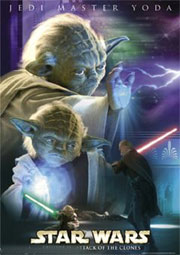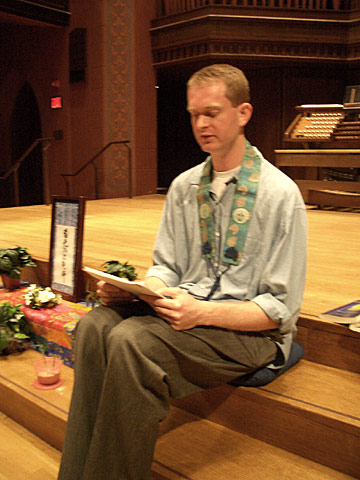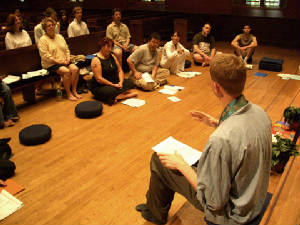|
| Star Wars and Buddhism Connection |
|
|
| Yoda: the Jedi Master |
Star Wars
and Buddhism
by Eli Williamson-Jones
This reading was
discussed on June 5, 2005
Universal Saga
The
story of the hero's journey, or mono myth, as it was called by Joseph
Campbell, transcends race, economics, culture and religion. The
psychologist and mythologist, Jonathan Young has said that, “when
enmeshed in a larger purpose, you are yourself, truly for the first
time,” and this is why we identify with the heroes of a story. As a
universal, this identification is sparked by the deepest longing within
us that seek to be connected to something greater than the self.
Theaters feed this part of us in a dark setting where a projector's
light flickers on the screen much like the faces of our ancestors in
the light of a campfire during story telling sessions.
One
of the most memorable hero’s journey stories told in the 20th and 21st
centuries is the Star Wars saga. This movie had panoramic appeal from
the very beginning and drew diverse masses of people into
theater-temples for a profoundly sacred experience. “The Force” (in Star Wars) was
conceived as a common denominator to
all religions – primitive to modern. The idea of an ideological core to world religion was a premise in the writings of Joseph Campbell, who George Lucas
called, “My Yoda” 1 The
most interesting aspect of the cultural phenomena of Star Was was that,
Christians, Buddhists, Hindus, Jews and Muslims found a spiritual
language that could connect their tradition to a younger generation of
religiously illiterate people. This is particularly true with
Buddhists, where Lucas himself has admitted that Star Wars was heavily
influenced by eastern thought.
Compassion
Frederick
Brenion beautifully illustrates the connection between Star Wars and
Buddhism in these excerpts from his internet article, Jedi-Shinshu.
...it
is when we first meet Yoda that we are struck by the similarities
between him and the examples and teachings of many Zen-masters. Later
in “Phantom Menace” we meet Padme Amidala, whose name; Padme is that of
“Lotus” from the mantra “Om Mani Padme Hum,” and Amidala, a feminine form for the Buddha Amida, the central figure in Pure Land beliefs. But it is in "Attack of the Clones" that we receive the
strongest signal yet of the centrality of Buddhist thought in the Jedi.
In a discussion Padme asks Anakin if Jedi are even allowed to "love,"
He says: "Attachment is forbidden. Possession is forbidden. Compassion,
which I would define as unconditional love, is central to a Jedi’s
life, so you might say we’re encouraged to love."
Much
of Buddhist practice is devoted to discovering our attachments and
getting rid of them. But of even more importance and really forming the
basis or ability for ridding oneself of attachments is that of
compassion. It is, as Anakin said, "central to a Jedi’s life." And it
is central to that of the Bodhisattva life, and the life of a Buddha. 2
The Present Moment
In the beginning of Star Wars Episode I, The
Phantom Menace, we learn the Jedi Knight’s teachings of mindfulness of the
Living Force is identical to the Buddhist teaching of mindfulness of the present moment. Jedi Master Qui Gon instructs his student Obi Wan, to not center on his anxieties and to keep his concentration in the here and now where it belongs. Anticipation of the future is sometimes
necessary but not at the expense of the moment. This is being mindful of the living Force.
Only by touching the present moment deeply in the here and now, are we able to live fully.
There is no life outside this present moment in the past or the future. When asked why his monks were so peaceful and serene, the Buddha said, “They
do not repent the past, nor do they brood for the future. They live in the present.” 3
|
|
| Screenwriter Eli Williamson-Jones giving this Star Wars & Buddhism Talk |
Interdependence
Besides
mindfulness of the moment, the Jedi share the Buddhist perspective of
interdependence. In his warning to the Gungans, Obi Wan uses the
argument that their fate is bound to their neighbors through the
interconnected nature of a symbiotic circle. “What happens to one of
you will affect the other.” This same argument is used in Buddhism to
illustrate the relationship we all share with the world and our
universe. The idea that we exist apart from
the whole as a “separate self” inhibits our enlightenment or greater understanding of reality as it is. Becoming aware of
symbiosis or interdependence will put us in accord with the, “right view” of things, an essential element of Buddha’s
eight-fold path.
Right View
Coming into a more authentic relationship with reality will show us that,
the “right view” of things isn’t necessarily dependent on what we perceive but on how we perceive it. We will
find that the perceptions we hold from images of the world are often false. Buddhist teachings tell us that “if there is
perception, there is
deception.” This is echoed in Star Wars when Obi Wan trains his Jedi
student to practice with his light saber with the blast shield down. He
tells Luke, “Your eyes can deceive you, don’t trust them.” It is a
false perspective of reality we create inside our minds that leads to
unnecessary suffering.
Right Effort
Arriving
at a more integral picture of reality can be achieved with sincerity
and devotion. This is what constitutes “right effort” in Buddhism which
also means consistent thoughts and actions taken towards a spiritual
peace and freedom. Yoda repeats the same sentiment in The Empire
Strikes Back as he trains a stubborn Luke Skywalker. “A Jedi must have
the deepest commitment, the most serious mind.”
Attachment
Most striking to Buddhism and Star Wars is the message of attachment being
an instigator of suffering. “It is attachment that will bring about Anakin’s downfall. In a Time magazine interview Lucas himself says: "He turns into Darth Vader because he gets attached to things. He can’t
let go of his mother; he can’t let go of his girlfriend.
He can’t let go of things. It makes you greedy. And when you’re greedy, you are on the path to the dark side, because you fear you’re going to lose things, that you’re not going to have the power you need." 2
In Revenge of the Sith, Yoda instructs
Anakin to, “Let go of everything you fear to lose.” The Buddha taught, “All phenomena that are born, exist, and are subject to the influence of other phenomena; in other words, all phenomena that are
composite, must abide by the law of impermanence and
eventually cease to exist. Everything we cherish and hold
dear today, we will have to let go of and be separated from in the future.” 3
Violence
Drawing
parallels between Star Wars and Buddhism will undoubtedly resonate with
some, more than it will others. Yes we can find similarities between
Buddhist philosophy and the teachings of the Jedi, but at a deeper
level, are their perspectives compatible? Star Wars is after all a
movie that revolves around violence and warfare. The teachings in
Buddhism revolve around non violence while seeking an end to warfare.
There are many Buddhists who will argue that violence can’t be
motivated by compassion and so the Jedi aren’t in accord with this
central tenet.
The
Hero’s Journey
But if one will take a closer look at Buddhism and Star Wars, they will see that each
ultimately concerns itself with the hero’s journey. It was Buddha himself who stated in the Dhamnapada,
“Though he should conquer a thousand men in the battlefield a thousand
times, yet he, indeed, who would conquer himself is the greatest hero."
This quote is perfectly personified in Star Wars through the character
of Luke Skywalker who finds himself trapped in the middle of duality –
a great inter-galactic and spiritual civil war. Like the path of the
Buddha, Luke is compelled on his heroes journey to find a cessation to
war and his suffering by conquering himself.
Light
& Darkness
Duality
as defined for this presentation is warfare. In Star Wars this warfare
is sustained by two opposing entities, the Light and Dark Side of the
Force. George Lucas has stated that these two sides are, "...designed
around compassion and greed. The issue of greed, of getting things and
owning things and having things and not being able to let go of things,
is the opposite of compassion-of not thinking of yourself all the time.
These are the two sides-the good force and the bad force. They're the
simplest parts of a complex cosmic construction."
When Luke is first drawn into this warfare, his most troubling question concerns
his dilemma, “Is the Dark Side stronger than the Light?” “The
father (Vader) reminds the son, (Luke) as if the devil were his higher
self, that without (higher) consciousness, “Your destiny lies with me, Skywalker.” 1 Obi Wan essentially tells Luke that, “Vader can never be turned. Those who embrace
the Dark Side are forever lost. There is no redemption for
such.” Obi Wan’s views are like those who opposed the teaching
in the Tannisho that Amida’s merciful vow is much more for the evil person. 2 In Star Wars, “the dark side represents an energy that we may regard as another form of
suffering.” 3 “In the Empire Strikes back, we
see the back of Vader’s head and know, “Whatever monster Vader
might be, this man had suffered, and suffered deeply.” 2
It
is in the fifth Star Wars movie that Luke undergoes rigorous Jedi
training and comes face to face with his own “Dark Side”. Yoda sends
Luke into a cave where he confronts an image of Darth Vader and cuts
off his head. “Darth Vader’s signature black helmet falls to the ground... ...Luke is shocked by the sight of his own
face inside the helmet.
His wide-open eyes stare back in disbelief. This is no faceless storm
trooper from an alien realm. Luke sees himself and must think, “I have
met the enemy and he is me.” 1 Mary Henderson (author of Star Wars: The Magic of Myth) wrote, “Darth
Vader is not an external evil presence but the shadow side of Luke himself.”
Upon
closer look at the guardians of peace and justice in the Star Wars
saga, one can see that the Jedi also share a shadow side with Luke
Skywalker. It is the Sith who are born from Jedi just like in the myth
of Satan being born from God. “The dark side does not spring up out of
nowhere. ...they (the Sith) are an offshoot of the Jedi themselves. The
Sith are in fact in the Jedi and the Jedi are in the Sith. Count Duku
was not only a fallen Jedi but a former padawan to master Yoda. Anakin
was a padawan to Obi Wan before he turned into a Sith. In referring to
the way the Jedi are too easily deceived, the movie Attack of the
Clones is punctuated by the line, “Only a Jedi could do this.” “When we peel back
the mask of evil in our society and in the world, we will find
our own face staring back at us.” 3
Luke’s
hero’s journey eventually brings him inside the heart of duality and
the eternal warfare raging within. Darth Vader wants Luke to kill the
Emperor and the Emperor wants Luke to kill Darth Vader. Obi Wan and
Yoda want Luke to kill both the Emperor and Vader. It is through
witnessing and conquering his shadow side and seeing the never ending
war raging on between the Light and Dark Side of the Force, that helps
Luke see good and evil must be transcended if his heroes journey is
ever to be complete. The means he uses to do this are the same means
the Buddha taught over 2,000 years ago. We all understand that love
without wisdom can create a kind hearted fool like Jar Jar Binks, while
intelligence without compassion can produce a heartless megalomaniac
like the Emperor. Through the interdependence of intelligence and love
we find wisdom and compassion.
The
Lotus Rises
Like Luke, with wisdom and compassion, we, “...cannot
look upon the evil of Darth Vader and fail to see the goodness present
in him. This does not mean we no longer feel anger or sorrow. Feelings
rise and fall but we are no longer bound to them like Anakin in Attack
of the Clones or Revenge of the Sith. Feelings arise and we are mindful
and watch emotions with detachment and they cannot drive us into
disastrous acts of slaughter.” 3
“Although
hatred, anger, aggression and other mental formations of the dark side
are unwholesome, if we are practicing the way that transcends the dark
side, they can nonetheless be transformed into wholesome elements.” 3 This is expressed with the symbol of the
lotus in Buddhism, which grows from the filth and the decaying matter of a swamp. Star
Wars is ultimately an antiwar film and that Luke is a prophetic wisdom
hero of peace. The universe is saved from the titans of death by a
solitary youth who turns off his light saber and turns on light
consciousness. 1 “Luke’s actions show us that ultimately the good
side of the force is stronger than the dark side.
The good side
is stronger because it includes the dark side.” 3 “While
Luke Skywalker best exemplifies the qualities of wisdom and compassion
in star wars, it is his father, Anakin who shows us the full range of
what it is to be human. ...Anakin goes from sweet kid to an arrogant,
temperamental young man, to a monster cloaked in the dark side. In his
life, he loved people, at times he hated himself, he sought the
approval of his teachers, he selflessly tried to help others, he made
mistakes, and he intentionally committed crimes of ignorance and of
wickedness. But in the end he finds freedom from the dark side. The
lesson of Anakin’s experience teaches us that everyone even the most
wicked, has the seed of liberation in his
heart.” 3
Cited Sources
1 = Peace Knights of the Soul – Wisdom in Star Wars by Jon
Snodgrass – pages: 48, 120, 108
2 = Jedi-Shinshu: The Buddhist Heart of Star Wars by Frederick Brenion
3 = The Dharma of Star Wars by Matthew Bortolin – pages: 5, 73, 18, 46, 129,
140, 152, 154
|
|
| Eli Williamson-Jones discussed the above reading to the BFF community |
Click below to enter
Mr. Williamson-Jones'
Star Wars Homepage.
CLICK HERE to visit Star Wars Site.
|









